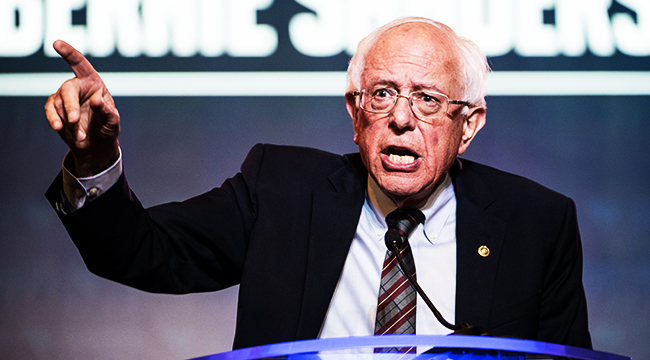
Presidential hopeful and current Senator Bernie Sanders wants to eliminate all $1.6 trillion of existing student loan debt, and he plans on introducing legislation that would do just that later today, Monday, June 24. He will introduce the legislation along with the bill’s co-sponsors, Minnesota Rep. Ilhan Omar and Washington Rep. Pramila Jayapal.
This plan comes just before the first primary debates of election season, which will be held later this week, on the tail of news that fellow presidential hopeful Elizabeth Warren has leap-frogged Sanders in the polls to take second place behind former Vice President Joe Biden. As other outlets have reported, Warren has quickly gained favor among voters for her comprehensive, progressive policy proposals, so it’s unsurprising that Sanders is trying to shore up his reputation as a progressive candidate who gets things done by introducing a hefty legislative package.
On its face, wiping out $1.6 trillion of student debt and making public higher education tuition-free seems like an outsized promise. How would Sanders’ legislation work? We break it down.
Wait, so he just wants to cancel all student loan debt?
https://twitter.com/jstein_wapo/status/1142977310808821760?s=12
Yes. Unlike with Warren’s plan — which would wipe up to $50,000 of student debt for households making $100,000 or less, then eliminate debt for households earning more in proportion to their earnings in an attempt to close the racial wealth gap — Sanders wants to eliminate all debt for all 45 million borrowers. If the legislation were to pass, all debt would be eliminated immediately, meaning if the bill were to pass the House and the Senate, and signed into law by President Donald Trump today, tomorrow every single cent of your student debt would be gone.
The legislation would simultaneously make public universities, community colleges, and trade schools tuition-free. His college-for-all package would also include “subsidies to reduce the cost of tuition and fees for low-income students at private colleges that historically serve underrepresented communities,” such as Historically Black Colleges and Universities and tribal colleges, per CNN.
How would it work?
The college-for-all plan wouldn’t just be a matter of poof! free tuition. It would be a federal match program in which the federal government would give funds to states and tribes in order to make tuition at public universities, colleges, and trade schools free or very low cost.
According to Vox, states and tribes would receive “at least $48 billion per year, through a two-to-one federal dollar match program” if they eliminate tuition and fees at public universities and colleges. They’d have to meet certain requirements, including:
- Covering the “full cost of higher education for the poorest families, those who earn less than $25,000.”
- Universities would have to “rely less” on adjunct faculty
- None of the money could go to administrators’ salaries, merit-based scholarships (only need-based), or non-academic buildings.
In order to help ensure equity, the plan would “cover 95 percent of costs to eliminate tuition and fees” at tribal colleges with “at least 75 percent low-income student enrollment.” As for HBCUs, many of which are private, the proposal includes $1.3 billion of funding per year to reduce tuition and fees at private schools where “at least 35 percent of students from low-income households.”
Sanders’s proposal would also increase the Pell Grant program and triple funding for Work-Study. Mean that though low or no-cost tuition would benefit students regardless of income, certain stipulations in the package would specifically target low-income students in order to ease the financial burden of higher education.
Sanders estimates that the plan would cost $2.2 trillion over 10 years.
How would we pay for it?
If we could bail out Wall Street, we sure as hell can #CancelStudentDebt.
— Bernie Sanders (@BernieSanders) June 24, 2019
Sanders will propose a new tax on Wall Street. Sanders initially proposed a Wall Street tax during his 2016 primary campaign, so it’s unsurprising to see it pop up again.
Here’s what Sanders is proposing: a 0.5 percent tax on stock transactions, a 0.1 percent tax on bonds, and a 0.005 percent tax on derivatives. In other words, anyone selling a $1,000 stock would owe a $5 tax; anyone selling a $1,000 bond would owe a $1 tax; anyone selling a $1,000 derivative would owe 5 cents.
The Sanders campaign says that this tax would benefit Americans in two ways: it would reduce speculative, algorithm-driven trading that detractors say destabilizes markets and favors large firms over individual traders; and it would, according to Sanders’s camp, also raise approximately $2.2 trillion in 10 years, which would fund student loan debt cancellation and college for all. That said, however, several think tanks and financial nonprofits, including the Congressional Budget Office, have estimated that the tax could net as low as $776 billion in 10 years.
